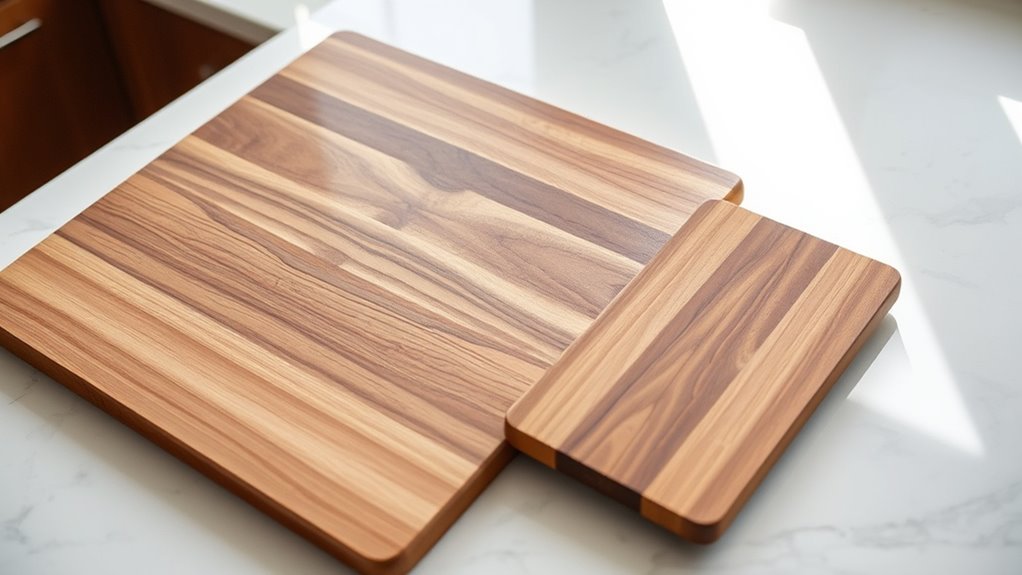Choosing the right size chopping board depends on your kitchen space and cooking habits. Smaller boards (around 8” x 12”) are perfect for quick prep tasks and are easy to handle, while larger ones (like 20” x 15”) suit bigger ingredients or multiple items at once. Be mindful of storage options and counter space to avoid clutter. Considering these factors helps improve safety and efficiency—continue exploring to find the perfect fit for your needs.
Key Takeaways
- Match the board size to your counter space, leaving 3-4 inches of clearance for safety and ease of movement.
- Consider the types of food prep you do most often; larger boards are ideal for big ingredients, smaller for quick tasks.
- Balance board thickness and material with your kitchen tasks for durability and knife preservation.
- Opt for space-saving or multi-purpose boards if storage is limited or for versatile kitchen use.
- Avoid oversized boards that clutter counters or bulky ones that are hard to clean and store effectively.
Understanding the Impact of Size on Kitchen Efficiency

Choosing the right size chopping board can substantially boost your kitchen efficiency. The right board dimensions help streamline food prep and optimize counter space. Large cutting boards, like 20” x 15”, allow you to prepare multiple ingredients at once, speeding up busy kitchen workflows. Small cutting boards, such as 8” x 12”, are lightweight and perfect for quick tasks, making handling easier. Size also impacts safety; a well-sized board provides enough space for safe knife movements, reducing slips and accidents. Additionally, matching your board size to your available counter space prevents overcrowding, helping maintain an organized work area. Using an ill-fitting board—either too large or too small—can hinder your food preparation tasks, cause spills, or create safety hazards, hampering overall kitchen efficiency. Considering proper kitchen tools like appropriately sized cutting boards can further enhance your cooking experience and efficiency. Ensuring your cutting board complements your overall kitchen setup, including counter space and storage options, is essential for optimal functionality. Properly selecting and maintaining cutting board materials can also extend its lifespan and performance. Moreover, selecting the right storage solutions for your cutting boards can help preserve their condition and keep your workspace clutter-free. Incorporating organizational strategies such as designated storage areas can further improve your kitchen’s overall flow and safety.
Exploring Common Cutting Board Dimensions and Their Uses

Understanding the range of common cutting board dimensions helps you select the right tool for your kitchen tasks. Cutting board sizes vary from small 8” x 12” boards to extra-large 18” x 24” models, catering to different kitchen needs. Standard size medium boards, around 17” x 11”, are versatile and perfect for most prep work. Large cutting boards, such as 20” x 15”, handle bigger ingredients like roasts or multiple vegetables at once. Extra-large boards work well for large groups or complex tasks like turkey carving. When choosing among wooden cutting boards, consider board dimensions and thickness—typically between 0.75” and 1.5”—to guarantee stability and durability. Matching the right size to your needs helps optimize your kitchen efficiency. Additionally, selecting appropriate materials for your cutting board can enhance its longevity and safety during food preparation. Using the correct cutting surface can also prevent knife damage and ensure safer handling, especially given the variety of food safety standards that may apply. Being aware of the foraging range of your tools and materials can help maintain a sustainable and safe kitchen environment. Moreover, understanding the cooking characteristics of different ingredients can influence the choice of cutting board size and material to prevent cross-contamination.
Considering Thickness and Material for Optimal Performance

The thickness and material of your cutting board substantially impact its performance and suitability for different tasks. Thicker boards, around 1.5 to 3 inches, excel at heavy-duty tasks like butchering, offering durability and stability. Thinner plastic boards, about 0.75 inches, are lightweight and ideal for quick prep. Wooden boards made from dense hardwoods such as maple or cherry provide a gentle cutting surface that helps preserve your knives and self-heal from minor cuts. End grain wooden boards, at least 2 inches thick, extend lifespan by reducing visible knife marks.
| Material | Thickness Range | Best For |
|---|---|---|
| Hardwood | 2+ inches | Heavy-duty, self-healing |
| Plastic/Rubber | 0.5-1 inch | Light prep, easy sanitation |
Evaluating Your Space and Cooking Habits Before Choosing a Size

Before selecting the right size chopping board, it’s important to contemplate your available space and how you typically cook. Measure your counter space carefully to guarantee the board fits comfortably, leaving 3-4 inches from the edge. Think about your kitchen habits—if you often prepare multiple ingredients, a larger board (like 20” x 15”) may be necessary; for quick tasks, smaller sizes (such as 8” x 12”) work well. Consider your storage options—larger boards need more cabinet or drawer space, which might be limited. Also, evaluate the types of food you prepare regularly; bigger boards handle large items better, while small ones suit fruits and cheeses. Ensuring your workspace is sufficient promotes safety and smooth food preparation. Additionally, selecting a design style that complements your kitchen decor can enhance your overall cooking environment. When choosing a size, keep in mind the material of the board, as some materials may be more durable and easier to clean, fitting your lifestyle better. Incorporating a non-slip base can also improve stability during use, especially on slippery surfaces. Moreover, considering home decor & design elements can help select a chopping board that seamlessly fits into your kitchen aesthetic.
Tips for Selecting a Practical and Versatile Cutting Board

Choosing a practical and versatile cutting board starts with selecting a size that fits seamlessly into your kitchen routine. The size of your cutting board impacts how well it handles your tasks and fits your storage options. A versatile cutting board should accommodate both quick prep and larger ingredients, so consider dimensions like 17” x 11” as a good starting point. Think about your typical tasks and choose a material that’s easy to clean and maintain, such as wood or plastic. Keep care in mind; larger boards may be harder to wash thoroughly, especially if they’re heavy or thick. Guarantee the size allows for easy storage in your cabinets or drawers, and select a cutting board that balances practicality with your needs for versatility. Additionally, selecting a size that matches your cooking style ensures optimal functionality and convenience.
Avoiding Common Mistakes When Picking the Right Size

Many people overestimate their counter space and end up with a chopping board that’s too big to handle easily. Ignoring your storage limits can make it a hassle to keep the board out or put away. To choose the right size, consider both your workspace and storage options carefully. Being aware of machine weight can also help ensure that your chosen board remains manageable if you need to move or store it frequently. Additionally, understanding the various headphone types can be useful if you plan to listen to music or follow recipes with audio guidance while cooking.
Overestimating Counter Space
It’s easy to overestimate how much counter space you have when selecting a chopping board, but doing so can make your kitchen feel cramped and cluttered. Incorrect measurement accuracy can lead you to choose a cutting board size that overwhelms your kitchen layout, reducing your prep area and creating workspace clutter. Larger boards, like 20×15 inches or more, might seem ideal but can cause storage issues, especially in small kitchens. When the board is too big, it hampers movement, complicates cleaning, and decreases kitchen efficiency. Always leave at least 3-4 inches of clearance from the counter edge to avoid crowding other appliances or creating safety hazards. Properly evaluating your counter space ensures your chosen board fits well and maintains a safe, functional kitchen environment. Additionally, understanding kitchen organization principles can help you select a size that optimizes your workspace without sacrificing functionality. Incorporating space-saving solutions such as foldable or multi-purpose boards can further enhance kitchen efficiency and prevent clutter. Being mindful of compact storage options can make a significant difference in small or crowded kitchens. For example, choosing a board with smart storage features can help maximize limited space and keep your kitchen organized. Moreover, considering the impact of AI on tech gadgets can inspire innovative storage ideas and smart solutions for small spaces.
Ignoring Storage Limitations
If you overlook your storage space, selecting a chopping board that’s too large can quickly turn into a hassle. Oversized boards that don’t fit in cabinets or drawers may require special storage or be left out on the counter, cluttering your kitchen. This reduces kitchen efficiency and makes handling and cleaning more difficult. Ignoring storage limitations can lead to choosing a board that’s too heavy or bulky, making it hard to move or transport. Additionally, considering the automation in business can help you find smarter storage solutions that streamline your kitchen setup and improve overall efficiency.
Frequently Asked Questions
How to Choose Cutting Board Size?
When choosing a cutting board size, consider your kitchen space and how much room you have to work with. Think about the types and amounts of ingredients you typically prepare—do you need a large surface or a smaller one? Start with a standard size like 17” x 11” and adjust based on your needs. Balance size with ease of cleaning, storage, and how it fits into your cooking routine.
How to Choose a Good Chopping Board?
Imagine your kitchen as a stage, and your chopping board as the perfect prop. To pick a good one, consider the material—wood or plastic—based on how much you prioritize knife safety or easy cleaning. Think about the size that fits comfortably on your counter and suits your cooking style. A sturdy, well-sized board makes prep safer, more efficient, and a pleasure rather than a chore.
What Is a Standard Chopping Board Size?
A standard chopping board size is typically around 12 inches by 18 inches, which works well for most kitchen tasks. You’ll find boards with a thickness of about 0.75 inches, offering a good balance of stability and portability. Many manufacturers design these boards to fit comfortably on your countertop without taking up too much space. For versatility, a 17” x 11” board is often a popular choice among home cooks.
Can a Cutting Board Be Too Big?
You might think any size is fine, but a cutting board can be too big, and it’s worth considering why. An oversized board can clutter your counter, making food prep feel overwhelming. It’s cumbersome to clean and transport, and it can block access to other tools. Smaller, well-suited boards keep your workspace efficient, comfortable, and manageable—so don’t let size weigh down your kitchen experience.
Conclusion
Choosing the right-sized cutting board is like finding the perfect puzzle piece—you’ll work more efficiently and enjoy your time in the kitchen. By considering your space, habits, and the board’s size, you’ll create a setup that feels just right. Remember, the right size isn’t just about fit; it’s about making your cooking flow smoothly like a well-conducted orchestra. Trust your instincts, and your kitchen will be singing in harmony.









